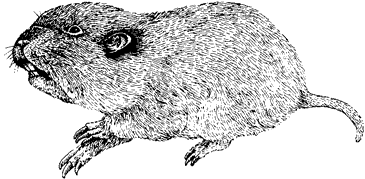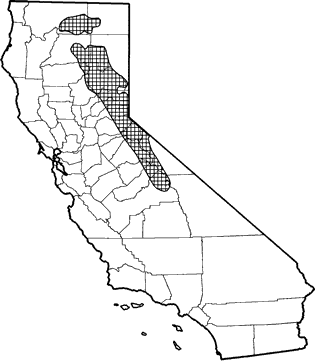
Mountain Pocket Gopher
Distribution, Abundance, and Seasonality
In California, the mountain pocket gopher occurs at elevations above 1520 m (5000 ft) in the Sierra Nevada, from Fresno Co. north to Shasta and Lassen cos. Occurs also in southeastern Siskiyou Co. and western Modoc Co. Abundant in alpine dwarf-shrub, perennial grassland, and wet meadow habitats. Deep soils at the margins of mountain meadows are preferred (Ingles 1952). Uncommon to common in a wide variety of habitats, including annual grassland and open forests and brushlands.

Range Map
Specific Habitat Requirements
Feeding: Feeds underground on roots, tubers, and bulbs, and above ground on stems and leaves of forbs and grasses. Shrubs and tree seedlings occasionally are eaten. Gophers may damage young conifers. Food, such as roots of Lewisia and small Brodiaea, may be stored in underground cavities.
Cover: Burrows are dug in friable soil. Complex underground tunnel systems are constructed, breaking surface where plants are taken and earth is pushed up in mounds.
Reproduction: A nest of dried vegetation is constructed in an underground nest chamber.
Water: Water is obtained from food.
Pattern: Deep, friable soils with moderate herbaceous cover are preferred.
Species Life History
Activity Patterns: Active throughout the day, although more active at night.
Seasonal Movements / Migration: Non-migratory.
Home Range: At Huntington Lake, home ranges were up to 0.2 ha (0.5 ac), but as small as 8 m? (85 ft?) (Ingles 1952).
Territory: Adult males are aggressively solitary toward other males. Adult male territories usually include several female territories.
Reproduction: Breeds from May to July. Gestation period unknown, but probably 3-4 wk. Litter size averages 3-4 (range 2-8) (Verner and Boss 1980). Usually 1 litter per yr. Probably breeds the spring following birth.
Niche: Predators include owls, hawks, coyotes, foxes, skunks, badgers, bobcats, weasels, and snakes. Of these, owls probably are the most important. Burrowing activites aid in mixing and building of soils, and percolation of water. To protect populations, overgrazing should be avoided.
Sources & References
California Department of Fish and Game, 1999.
California's Wildlife, Sacramento, CA.
Written by: P. Brylski, reviewed by: H. Shellhammer, edited by: R. Duke
Ingles, L. G. 1949a. Ground water and snow as factors affecting the seasonal distribution of pocket gophers, Thomomys monticola. J. Mammal. 30:343-350. Ingles, L. G. 1952. The ecology of the mountain pocket gopher, Thomomys monticola. Ecology 33:87-95. Thaeler, C. S., Jr. 1968. An analysis of the distribution of pocket gopher species in northeastern California (Genus Thomomys). Univ. Calif. Publ. Zool. 86:1-46. Verner, J., and A. S. Boss. 1980. California wildlife and their habitats: Western Sierra Nevada. USDA, For. Serv. Gen. Tech. Rep. PSW-37. 439pp. Volland, L. A. 1974. Relation of the pocket gophers to plant communities in the pine region of central Oregon. Pages 149-166 in H. C. Black, ed. Wildlife and forest management in the Pacific Northwest. For. Res. Lab. Oregon State Univ., Corvallis. 236pp.
California Animal Facts | California's Wildlife